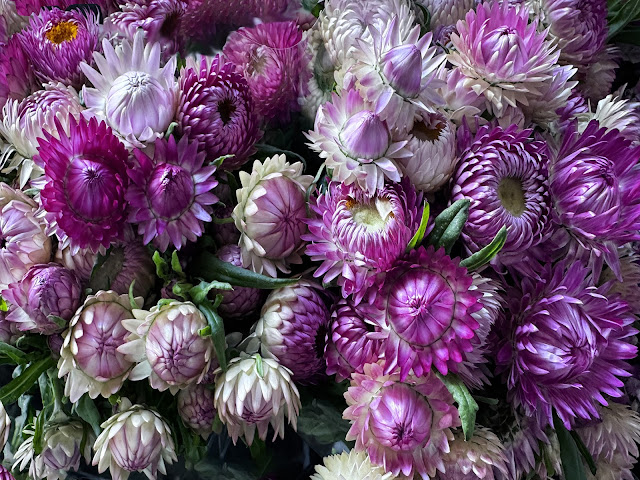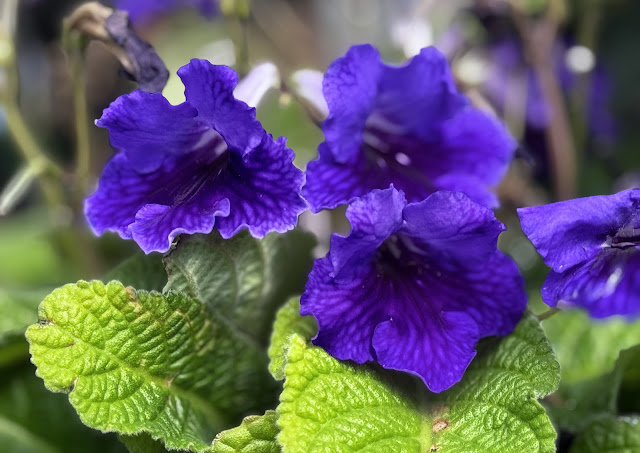Rhodanthe, also known as sunray or pink paper daisy, is a genus of Australian plants in the pussy's-toes tribe within the daisy family, Asteraceae. The name Rhodanthe is derived from Greek rhodon, rose and anthos, flower. Many Rhodanthe species were formerly classed under different genera, including Helipterum, Podotheca, Acroclinium and Waitzia.
Rhodanthe chlorocephala subspecies rosea (shown here) is the most widely grown subspecies and is commonly known as “Pink and White Everlasting”, “Rosy Sunray”, “Pink Paper-daisy” and “Rosy Everlasting”. It grows naturally in the south of Western Australia extending into South Australia. Rhodanthe chlorocephala subsp. rosea is an erect annual herb 20-60cm high with clumps of glabrous (hairless) grey-green stems and leaves 1-6cm in length. It has a large single flowering head at the tip of each stem. Flower heads grow to 6cm diameter, gradually decreasing as the flowering season progresses.
The colour of the bracts varies from deep pink (almost red) through pale pink to pure white, with a yellow or black centre. Stems branch early in the season. You can encourage this habit (to create more blossoms) by pinching out the growing tips. Rhodanthe chlorocephala subsp. rosea is adaptable and ephemeral, springing up whenever conditions are right e.g. during warm, sunny weeks anytime of the year. It prefers full sun to dappled shade and grows well in open woodland. Grown in full shade it tends to be long and spindly.
It thrives in well-drained sandy soils and tends to be smaller when grown in heavy, clay soils. It generally flowers from August to November in the wild but with sufficient water and warmth it will flower at other times. It flowers 10 to 12 weeks after germination and the flowers last a good two weeks. The flowering period lasts 4 to 10 weeks. Fruit appear approximately 4 weeks after flowering.
Join me for Floral Friday Fotos by linking your flower photos below, and please leave a comment once you have done so!
Rhodanthe chlorocephala subspecies rosea (shown here) is the most widely grown subspecies and is commonly known as “Pink and White Everlasting”, “Rosy Sunray”, “Pink Paper-daisy” and “Rosy Everlasting”. It grows naturally in the south of Western Australia extending into South Australia. Rhodanthe chlorocephala subsp. rosea is an erect annual herb 20-60cm high with clumps of glabrous (hairless) grey-green stems and leaves 1-6cm in length. It has a large single flowering head at the tip of each stem. Flower heads grow to 6cm diameter, gradually decreasing as the flowering season progresses.
The colour of the bracts varies from deep pink (almost red) through pale pink to pure white, with a yellow or black centre. Stems branch early in the season. You can encourage this habit (to create more blossoms) by pinching out the growing tips. Rhodanthe chlorocephala subsp. rosea is adaptable and ephemeral, springing up whenever conditions are right e.g. during warm, sunny weeks anytime of the year. It prefers full sun to dappled shade and grows well in open woodland. Grown in full shade it tends to be long and spindly.
It thrives in well-drained sandy soils and tends to be smaller when grown in heavy, clay soils. It generally flowers from August to November in the wild but with sufficient water and warmth it will flower at other times. It flowers 10 to 12 weeks after germination and the flowers last a good two weeks. The flowering period lasts 4 to 10 weeks. Fruit appear approximately 4 weeks after flowering.
Join me for Floral Friday Fotos by linking your flower photos below, and please leave a comment once you have done so!
****If you take part in the meme, please show an active link back to this site on your own blog post!****










